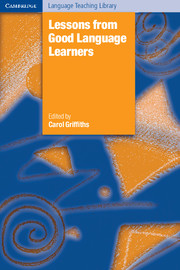Book contents
- Frontmatter
- Contents
- List of contributors
- Acknowledgements
- Editor's overview
- Prologue
- Reflections
- Part I Learner variables
- Part II Learning variables
- 12 Vocabulary and good language learners
- 13 Grammar and good language learners
- 14 Functions and good language learners
- 15 Pronunciation and good language learners
- 16 Listening and good language learners
- 17 Speaking and good language learners
- 18 Reading and good language learners
- 19 Writing and good language learners
- 20 Teaching/learning method and good language learners
- 21 Strategy instruction and good language learners
- 22 Errors correction and good language learners
- 23 Tasks and good language learners
- The learners' landscape and journey: a summary
- Index
19 - Writing and good language learners
Published online by Cambridge University Press: 11 August 2009
- Frontmatter
- Contents
- List of contributors
- Acknowledgements
- Editor's overview
- Prologue
- Reflections
- Part I Learner variables
- Part II Learning variables
- 12 Vocabulary and good language learners
- 13 Grammar and good language learners
- 14 Functions and good language learners
- 15 Pronunciation and good language learners
- 16 Listening and good language learners
- 17 Speaking and good language learners
- 18 Reading and good language learners
- 19 Writing and good language learners
- 20 Teaching/learning method and good language learners
- 21 Strategy instruction and good language learners
- 22 Errors correction and good language learners
- 23 Tasks and good language learners
- The learners' landscape and journey: a summary
- Index
Summary
Getting learners to engage in writing in the target language with any degree of enthusiasm can be a challenge for teachers. Perhaps this reflects the effort which must be exerted in order to write competently in a first language: doing the same in a new language therefore seems altogether too difficult. And to make it even more difficult for aspiring target language writers, in addition to linguistic knowledge, the socio-cultural nature of writing, involving prior knowledge, knowledge of genre and register, and cultural expectations may in fact hinder attempts to transfer competence in first language writing to another language (Hyland, 2003).
Writing in the language classroom is often seen as an extension of or support for the other skills. It may, for example, be used to consolidate the learning of grammar or vocabulary or be used as preparation for a speaking activity: jotting down intended dialogue will give the students time to think and therefore improve confidence and fluency. The opportunity to write in order to become a better writer does not often predominate in the language classroom (Harmer, 2004).
Given, however, that there are many language learners who go on to do further studies in the target language, competency with writing in the target language is becoming increasingly relevant to the needs of speakers of other languages. Therefore, it is not uncommon that classes are now given over to the specific teaching of this skill.
- Type
- Chapter
- Information
- Lessons from Good Language Learners , pp. 244 - 254Publisher: Cambridge University PressPrint publication year: 2008
- 8
- Cited by



